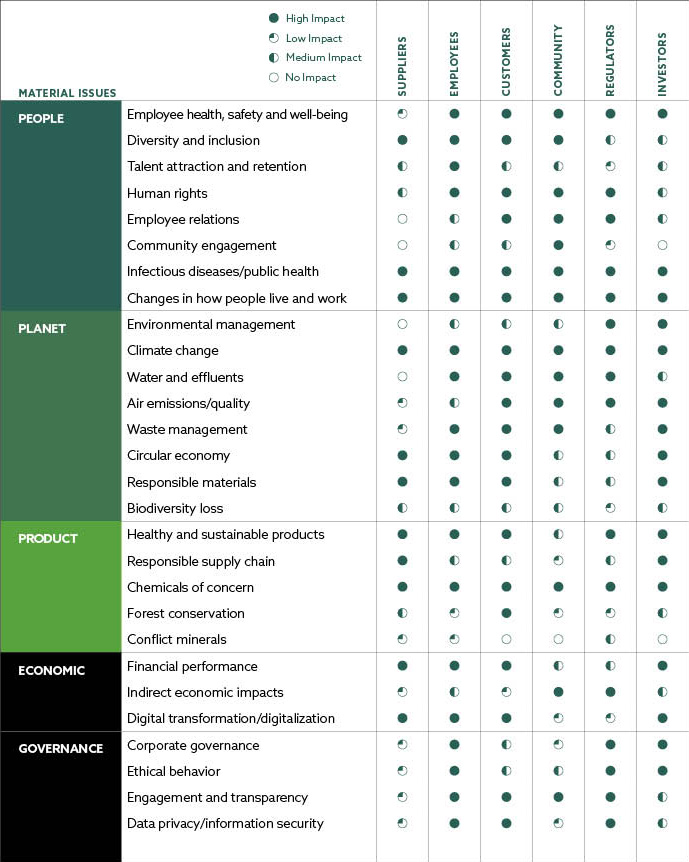For this year’s materiality analysis, we evolved our approach to begin building in the concept of ‘dual materiality’ - that is, assessing sustainability issues from a stakeholder perspective and also including a more focused look at financial materiality.
The process
In 2021 and 2022, we looked at issues from an external stakeholder and internal perspective through interviews, rater and ranker analyses, ESG reporting frameworks, industry thought pieces, and competitive benchmarking – this year’s analysis included over 50 sources of information. We also gathered feedback in an internal materiality workshop with key executives and SMEs both years. However, this year to increase the perspective related to financial materiality, we used several sources as a proxy, including the SASB Construction Materials Standard and opinions from several key investors and executives.
In this report, we are continuing to communicate our materiality analysis primarily from a stakeholder perspective. However, we found the financial perspective to be influential in our understanding of the wider non-financial context. We see themes of financial and non-financial materiality as mutually reinforcing across many stakeholders.
Several themes stood out, including the consequences of the pandemic and war in Ukraine, the interconnected effects of climate change, fundamental shifts in how we live and work, and a maturation of ESG transparency.
The Global Context
The consequences of the pandemic and conflict in Ukraine
After the ongoing disruption of the pandemic led to sustained supply chain disruptions, the conflict in Ukraine added further complication to global markets, including a shock to energy and food prices. Our products, which depend on the availability of discretionary spending for renovations, have also been affected by an inflationary environment, rising input costs and a shortage of labor in the construction sector. While Armstrong has been able to weather these challenges to date, we recognize that many of our suppliers and customers are facing growing constraints, which are likely to have an effect on our business. This might include material shortages, commercial construction project delays, and generally rising cost of doing business.
The interconnected effects of climate change
Society is waking up to the accelerated impacts of climate change. Climate change is interconnected with many social and environmental issues, from biodiversity and water scarcity, to human health and safety, food security, energy security, and human rights. As a company that is in the business of creating products and services for the built environment, we have important relationships not only with the managers of and occupants within those buildings, but the environment outside those four walls. We aim to create healthy and sustainable products, use responsibly sourced materials efficiently, and respect human rights along the supply chain.
Climate change will affect the availability and quality of natural resources, and as a heavy user of water and energy, it is essential we use them efficiently. We continue to use and investigate circular models to reduce material use and waste. We see this as an ongoing goal in the face of resource constraints. In addition, it is important that we continue to minimize effluents and air emissions.
Expectations are also changing, as a result of these climate-related shifts. We see governments in our key markets starting to set rules and legislation to prepare us for a carbon-constrained future. In addition, leading customers, including those in government and the tech sector, are increasingly asking their suppliers to help them meet their own sustainability goals, and to provide transparency through third party certifications on issues such as chemicals of concern, water, emissions, carbon footprints and responsible materials. These efforts align with our own sustainability strategy, and we have a critical role to play in meeting our customers’ needs.
Fundamental shifts in how we live and work
In addition, many people have begun to explore different choices in the ways they live and work. During the pandemic, a larger than expected number of older workers retired, and a larger number of women workers left the workplace than previous years. Remote working also became the norm in many workplaces, and the move to return to work has increasingly become more flexible. The Great Resignation has increased the competition for talent, which has led companies to use new techniques for attracting and retaining employees, including emphasizing corporate purpose, offering flexible work arrangements, providing training and a focus on well-being. Additionally, there has been an increased focus on employee relations and health and safety. Lastly, as society becomes more diverse, the issue of diversity, equity and inclusion continues to be an important area to reflect stakeholders’ expectations and serve society more broadly.
Community engagement has become a way for many organizations to support social and environmental causes, and the people and places where employees live and work. They are also a way to build employee engagement, skills development and belonging.
A maturation of ESG transparency
While reporting on financial performance and corporate governance are relatively established practices, recent efforts to prevent greenwashing, and to regulate and standardize ESG reporting in the US and globally, has meant greater scrutiny on engagement and transparency efforts. In particular, tying material topics to governance, strategy, risk management and metrics and targets is now the focal point for many frameworks going forward. We have also seen more focus on ethical behavior through an expansion of disclosure from the UN Global Compact Early Adopter Programme.
Our Materiality Analysis
The materiality analysis is as follows:
